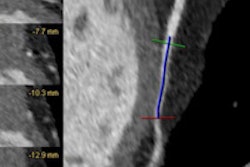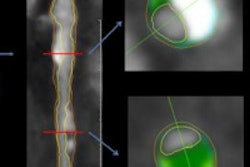
A new study of diabetes patients shows a direct relationship between body mass index (BMI) and the soft coronary artery plaques found on coronary CT angiography (CCTA) that portend a high risk for coronary events, according to research published online in Radiology.
The study is a major step forward for researchers' ability to assess vulnerable soft plaques noninvasively to assess disease risk, according to the study authors. Routine screening of high-risk diabetes patients could have a dramatic impact on preventing heart attacks and reducing mortality in these patients, they concluded. Because diabetes patients with higher BMI had proportionally greater soft-plaque volumes, reducing BMI represents an important therapeutic goal for reducing the risk of adverse cardiovascular events, they stated (Radiology, April 22, 2014).
Because many patients with type 2 diabetes are either overweight or obese, the study confirms the importance of obesity management for patients in addition to other risk factors, co-investigator Dr. David Bluemke, PhD, told AuntMinnie.com in an interview. The cohort was on average obese, and the degree of obesity was related to the amount of plaque.
"It was an effect equal in size almost to something as strong as aging: One unit increase in BMI had the same magnitude effect as a year of aging," Bluemke said. "So you can think of obesity as sort of premature vascular aging for these diabetics."
Plaque at risk
Coronary artery plaque can restrict blood flow and sometimes rupture, leading to heart attacks. But not all plaque is created equal. Considerable evidence shows that noncalcified plaque is less stable and more prone to rupture than other plaque types.
So for most individuals at risk of coronary artery disease, the coronary artery calcium (CAC) score is an adequate prognosticator of future adverse events. But CAC has a low specificity for cardiovascular disease outcomes in patients with diabetes and little propensity to change in response to therapy, suggesting that noncalcified plaque may play an important role in the cardiac event risk profiles of diabetes patients and also in risk management.
How to detect vulnerable "soft" plaques? Intravascular ultrasound (IVUS) can do it, but the modality is invasive and not conducive to screening. Coronary CTA is better, and the technique has been validated with histological exams for assessing plaque volumes, both calcified and noncalcified, the authors wrote.
"We usually think of CCTA as imaging focal stenosis, but we're coming to the point where you can analyze the entire coronary tree and all the plaque and get an index of that plaque, kind of like a coronary calcium score," Bluemke said. "The second issue is whether all that plaque adds information beyond the calcium score, which is what we suspected."
Coronary plaque volume imaging (PVI), which uses software to quantitatively assess CCTA images, is a possible solution, and seems quite reliable, the authors noted. Plaque volume assessment and CCTA together are both clinically feasible and reproducible in patients with diabetes, and could potentially be applied across large populations of at-risk patients, wrote principal study author Alan Kwan and colleagues from Intermountain Medical Center in Salt Lake City, along with researchers from the National Institutes of Health in Bethesda, MD, and from Johns Hopkins University in Baltimore.
In the study, the researchers looked at 224 asymptomatic individuals with diabetes (121 men; mean patient age, 61.8 years), who had been diagnosed with diabetes a mean 13 years earlier, using CCTA and a quantitative plaque volume imaging technique to evaluate the soft plaques that tend to pose the greatest risk of major coronary events. The study cohort consisted of the entire screening arm of the Screening for Asymptomatic Obstructive Coronary Artery Disease Among High-Risk Diabetic Patients Using CT Angiography, Following Core 64 (Factor-64) trial.
Following administration of beta-blockers to achieve a heart rate of 60 beats per minute or less in the patients and intravenous contrast administration, the study team acquired images on a 64-detector-row scanner (Aquilion 64, Toshiba America Medical Systems) and obtained Agatston method CAC scores from noncontrast scans using 3-mm collimation and 3-mm-thick slices. CCTA images were acquired using retrospective gating at 120 kV and 350 mAs to 500 mAs, with a gantry rotation of 0.4 sec.
Two experienced readers blinded to clinical data assessed coronary artery wall volume in all three vessels on a Vitrea fX workstation (Vital) to quantify plaque subtypes. The coronary PVI was determined by dividing wall volume by coronary length, the authors explained.
Less calcium, more soft plaque, strong relation to BMI
The results showed that only about one-third of the patients' plaque was calcified, "which further suggests a strong role for coronary CT angiography in the assessment of the biologic determinates of plaque in diabetic patients," the authors wrote.
The mean CAC score was 206 ± 460 in women and 533 ± 89 in men, with a mean proximal PVI of 11.2 mm that included 18% soft plaque, 49% fibrous plaque, and 33% calcified plaque. And although PVI was greater in women, the relative composition of the plaque was similar between both groups.
A univariate analysis showed that PVI was associated with age, male sex, type 2 diabetes, disease duration, BMI, hypertension, high-density lipoprotein cholesterol level, and creatinine level (p < 0.03 for all), Kwan and colleagues reported. More soft plaque was found in younger patients with a shorter disease duration (p = 0.02), and the soft plaque percentage was directly related to BMI (p = 0.02).
"In the multivariable models, obesity was the most important of the factors related to cholesterol and blood pressure management and the development of an association with coronary plaque," Bleumke noted.
Measurement of both calcified and noncalcified plaque with CCTA is feasible and reproducible, Kwan and colleagues wrote. Moreover, the extent of plaque in asymptomatic diabetes patients is related to BMI and duration of diabetes. BMI was also associated with a greater percentage of soft plaque.
Quantitative CCTA plaque analysis is relatively new, but it has been validated using histological examination and intravascular ultrasound, they wrote. CCTA's main challenges have been the time-consuming analysis, the inadequate software tools, unclear reproducibility, and lack of biologic correlation. "The current study and others show that these limitations are being overcome," the researchers wrote.
Among the study limitations, the patient population was relatively homogeneous and from a single site, with little racial variation, the group noted. Moreover, data on family history of cardiovascular disease were limited, and patients with severe renal failure were not eligible to be scanned. Finally, they noted, plaque volume measurements can be affected by technical factors such as tube voltage and contrast injection rate.
Coronary PVI at CCTA is both clinically feasible and reproducible in diabetes patients and "could potentially be applied as a novel test to all at-risk patients," they wrote.
Next steps
CT delivers radiation, so mass screening "is not something we're going to be thinking about right now," Bluemke said. Then again, current techniques for CCTA can image the entire coronary tree at "radiation levels we used to use to perform CAC by itself," he said.
However, a couple of important steps will help move the research forward from here, Bluemke said. The first would be to note the stenosis, BMI, and PVI status of patients and "continue to follow them to determine which are at greatest risk looking at the plaque indices relative to what happens to them downstream," he said.
The second step is to start with the PVI as a status of a patient's disease and "look to modify the amount of plaque now that we can more directly measure the impact of treatment on the coronary arteries," Bluemke said.




















